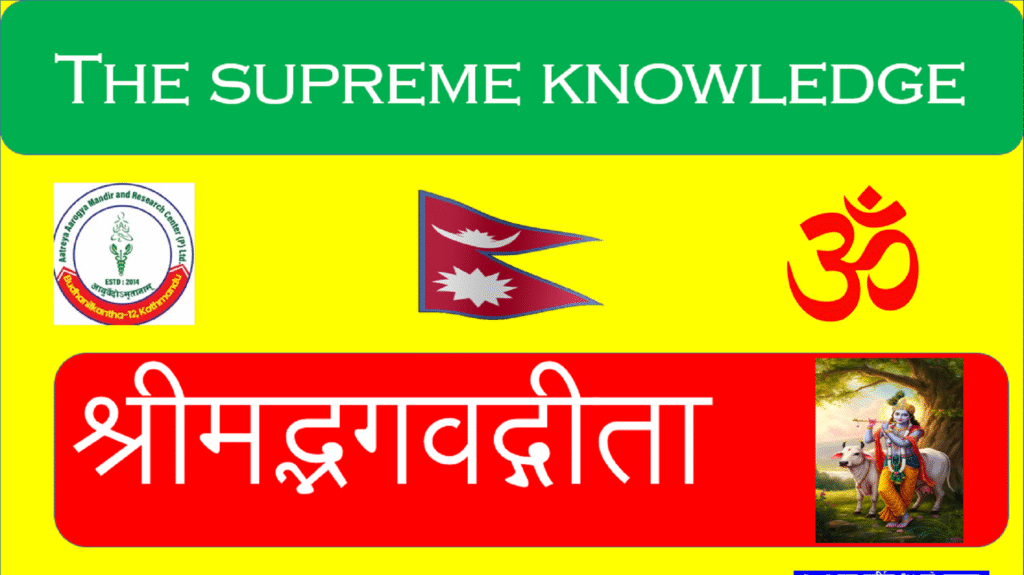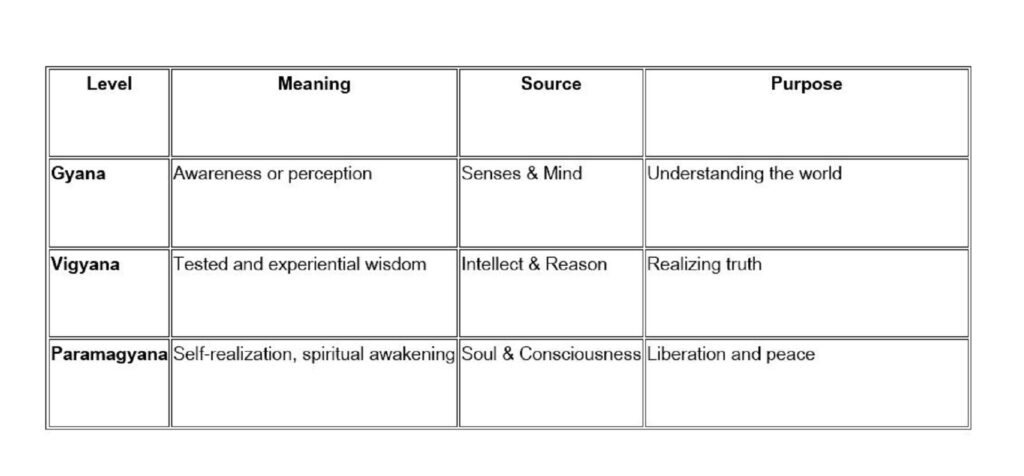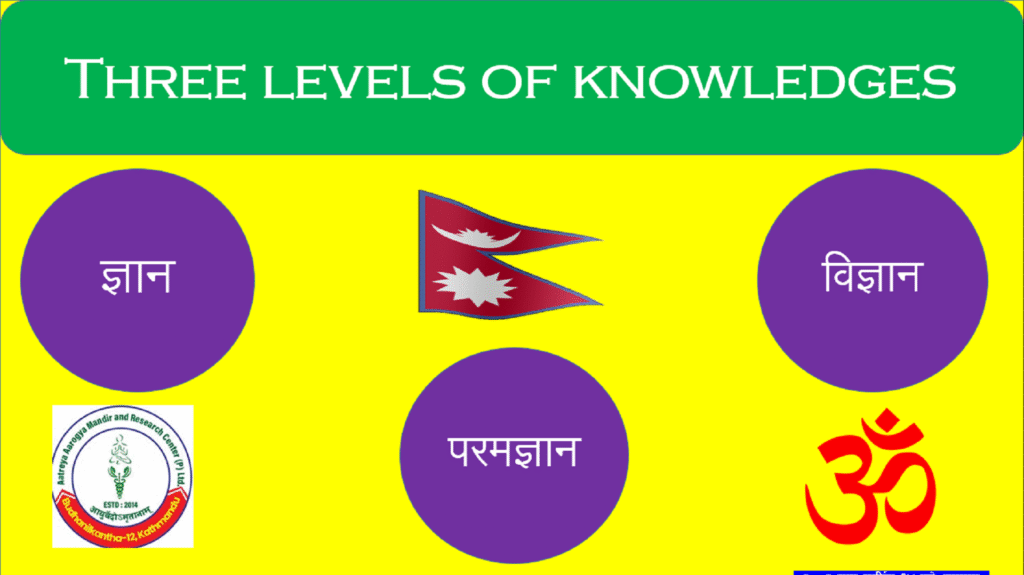Gyana, Vigyana and Paramagyana: The Three Levels of Knowledge in Ayurveda and Vedic Philosophy
Table of Contents
Introduction
The essence of human life lies in knowledg the awareness that illuminates consciousness and guides life’s purpose. In the Vedic and philosophical traditions, Gyana (knowledge), Vigyana (science or experiential wisdom), and Paramagyana (supreme knowledge) are not mere linguistic variations but represent three ascending stages of consciousness.
श्रुतेः स्मृतेः च विज्ञानं आत्मनः परमं पदम् ।- उपनिषद्
“Shruteḥ smṛteḥ ca vijñānam ātmanaḥ paramam padam”- Upanishad
This means: Knowledge and realization lead the self toward its highest state.
Gyana – The First Light of Awareness


Definition
Gyana (ज्ञान) means cognition – the awareness of an object, state, or truth. It arises through the interaction of the senses, mind, intellect, and consciousness.
In Sanskrit:
“इन्द्रियार्थसन्निकर्षोत्पन्नं ज्ञानम्”
“Indriyārtha-sannikarṣotpannaṃ jñānam” – Knowledge arises from the contact of sense and object.
Philosophical Perspective
Philosophically, Gyana is the dawn of consciousness – the light that dispels ignorance (Avidya).
Vedanta defines it as Self-awareness – the realization of one’s own nature:
“आत्मानं विद्धि”
“Ātmānaṃ viddhi” – Know thyself.
Ayurveda View
In Ayurveda, knowledge arises from the proper functioning of Manas (mind), Buddhi (intellect), and Ahankara (ego).
“मनः बुद्ध्यहंकारचित्तानि अन्तरङ्गानि”
“Manaḥ buddhya-haṃkāra-cittāni antarāṅgāni” – These inner faculties generate awareness.
Thus, Gyana is the foundation of all understanding – sensory, intellectual, and intuitive.
Vigyana – Experiential and Practical Knowledge

Definition
Vigyana (विज्ञान) means discriminative and experiential knowledge – the understanding that comes through direct experience, reasoning, and verification.
“विनिश्चये ज्ञाने विज्ञानम् – “Viniścaye jñāne vijñānam” – Tested and confirmed knowledge is Vigyana.
Relation to Modern Science
In modern usage, Vigyana is often equated with science – knowledge based on experiment and evidence.
However, in Vedic philosophy, Vigyana extends beyond physical observation to include psychological and spiritual realization.
Ayurveda contains various branches of Vigyana:
Dravya-Vigyana – Science of substances and herbs
Sharira-Vigyana – Anatomy and physiology
Mano-Vigyana – Psychology and mental health
Psychological Perspective
In psychology, Vigyana corresponds to applied cognition – when knowledge transforms into skill and understanding through experience.
Hence, Gyana becomes Vigyana when theory turns into lived wisdom.
Paramagyana – The Supreme Knowledge

Definition
Paramagyana (परमज्ञान) is the highest realization – the knowledge of the oneness between Atman (Self) and Brahman (Universal Consciousness).
“अहं ब्रह्मास्मि”, “तत्त्वमसि”, “सर्वं खल्विदं ब्रह्म”
“Aham Brahmāsmi” (I am Brahman)
“Tat Tvam Asi” (Thou art That)
“Sarvam Khalvidam Brahma” (All this is indeed Brahman)
These Upanishadic statements express the essence of Paramagyana.
Spiritual Perspective
Paramagyana transcends duality. The knower (Gyata), knowledge (Gyana), and known (Gyayan) merge into one.
It is the realization – “I am not the body, not the mind, but pure consciousness.”
This leads to liberation (Moksha), freedom from fear, sorrow, and illusion.
Ayurveda Understanding
In Ayurveda, Paramagyana means understanding life in its totality – body, mind and soul as a unified continuum.
“तस्य हेतुः परमं ज्ञानम्”
“Tasya hetuḥ paramam jñānam” – True cause of disease and health is known only through supreme knowledge.
Thus, Paramagyana brings health, peace, and self-liberation.
Interrelationship between the Three

Contemporary Relevance
In today’s world of information overload:
Gyana is easy – information is everywhere.
Vigyana is rare – experience and application require discipline.
Paramagyana is exceptional – it demands introspection, meditation, and inner purity.
Ayurveda, Yoga and Vedanta provide the complete path from Gyana to Vigyana to Paramagyana, transforming outer knowledge into inner illumination.
Conclusion
Gyana shows the path,
Vigyana walks the path,
Paramagyana transcends the path.
“विद्यया अमृतमश्नुते” — उपनिषद्
“Vidyayā amṛtam aśnute” – By true knowledge, one attains immortality.
Knowledge, science, and supreme wisdom are the three flames of human enlightenment, illuminating body, mind, and soul alike.
Aatreya Ayurveda Summary
Gyana: Awareness of body, senses and mind.
Vigyana: Practical application of Ayurveda principles – diet, behavior, herbs, and mental discipline.
Paramagyana: Realization of unity between Self, Nature, and Universal Consciousness – “स्वस्थस्य स्वास्थ्यरक्षणं, आत्मानं विज्ञाय” Swasthasya Swasthya Rakshanam, Ātmānam Vijñāya (preserving health through self-realization).


